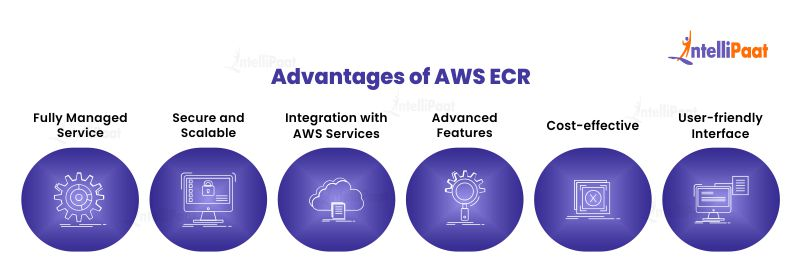What is AWS ECR?
AWS ECR provides a highly available and scalable environment for storing and managing Docker container images, which can be accessed securely from anywhere. This post demonstrates how ECR might improve the efficiency of your container process with the help of various features.
Given below are the topics we are going to cover:
- What do you Understand from AWS ECR?
- Why do we need AWS ECR?
- How does AWS ECR Work?
- Difference between AWS ECR and ECS
- Advantages of AWS ECR
- Conclusion
Check out this insightful video on the AWS Tutorial for Beginners
{
“@context”: “https://schema.org”,
“@type”: “VideoObject”,
“name”: “video”,
“description”: “What is AWS ECR?”,
“thumbnailUrl”: “https://img.youtube.com/vi/xdqZ_Y9JNp0/hqdefault.jpg”,
“uploadDate”: “2023-06-22T08:00:00+08:00”,
“publisher”: {
“@type”: “Organization”,
“name”: “Intellipaat Software Solutions Pvt Ltd”,
“logo”: {
“@type”: “ImageObject”,
“url”: “https://intellipaat.com/blog/wp-content/themes/intellipaat-blog-new/images/logo.png”,
“width”: 124,
“height”: 43
}
},
“embedUrl”: “https://www.youtube.com/embed/xdqZ_Y9JNp0”
}
What do you Understand from AWS ECR?
AWS ECR is a container registry service provided by Amazon Web Services. It is specifically designed to enable secure, scalable, and efficient storage, management, and deployment of Docker container images.
ECR offers a simple and intuitive interface that facilitates the easy pushing and pulling of container images. These images are automatically replicated across multiple availability zones for enhanced durability and availability.
Furthermore, ECR is highly integrated with other AWS services, such as ECS and EKS, allowing users to deploy containerized applications effortlessly. With advanced features like granular access control, vulnerability scanning, and lifecycle policies, ECR helps streamline container management and deployment processes for better efficiency.
Do you need the best AWS training in your area? Attend the AWS Certification Training at Intellipaat immediately!
Why do we need AWS ECR?
AWS ECR is vital for container-based applications. Let’s see the several reasons to know the necessity of AWS ECR:

- Provides Security and Dependability: AWS ECR provides a secure and dependable means of storing and managing Docker container images. ECR’s straightforward interface for pushing and pulling container images guarantees their distribution and replication across multiple availability zones, ensuring high availability and durability.
- Integrates with other AWS services: ECR integrates seamlessly with other AWS services like Amazon Elastic Container Service (ECS) and Amazon Elastic Kubernetes Service (EKS). This integration simplifies the deployment and management of containerized applications, allowing users to benefit from these services without worrying about the underlying infrastructure.
- Offer Advanced Features: ECR offers advanced features such as granular access control, image vulnerability scanning, and lifecycle policies that make container management and deployment easier.
Overall, AWS ECR offers a fully-managed and scalable container registry service that makes deployment and administration of containers easier, making it a crucial tool for developers and businesses that depend on container-based applications.
Interested in learning more? Go through this AWS Tutorial to gain a better understanding of AWS.
How does AWS ECR Work?
Let us see the working process of AWS ECR, which is widely used in Azure technology:
AWS Elastic Container Registry (ECR) operates by initially establishing a repository for users to house their container images. Subsequently, users have the capability to upload their Docker container images to the repository employing the Docker CLI, AWS CLI, or AWS SDKs.
Once a container image is pushed to the ECR repository, ECR stores it in an S3 bucket and replicates it across multiple availability zones to ensure high availability and durability.
To access their container images from other AWS services like Amazon ECS and Amazon EKS, ECR automatically generates an authentication token for users. Users can also control access to their container images using IAM policies, which specify user roles and permissions.
ECR integrates seamlessly with Amazon ECS and Amazon EKS, enabling users to deploy and manage containerized applications using these services. Advanced features like image scanning for vulnerabilities, lifecycle policies, and cross-account replication are also offered by ECR to simplify container management and deployment.
Difference between AWS ECR and ECS
Here’s a tabular comparison of AWS ECR and ECS that will provide the key differences:
| Feature | AWS ECR | AWS ECS |
| Service Type | Container Registry | Container Orchestration Service |
| Primary Use | Storing, managing, and deploying container images. | Orchestrating and managing containerized applications. |
| Use Cases | Building and deploying container-based applications. | Deploying, scaling, and managing containerized applications. |
| Pricing Model | Pay-as-you-go based on data storage and data transfer. | Pay-as-you-go based on the number of running container instances and associated resources. |
| Integration | Integrates with Amazon ECS, Amazon EKS, and other AWS services. | Integrates with other AWS services like EC2, EKS, and Fargate. |
Advantages of AWS ECR
AWS ECR offers several benefits for container-based applications, making it a valuable tool for users who are working on an AWS platform. The benefits are elaborated further:

- Fully Managed Service: Since AWS ECR is a fully managed service, AWS is responsible for the scaling, availability, and security of the underlying infrastructure.
- Secure and Scalable: AWS ECR offers secure and reliable storage for Docker container images. The images are stored in an S3 bucket and replicated across multiple availability zones, ensuring high availability and durability.
- Integration with AWS Services: AWS ECR seamlessly integrates with other AWS services, including Amazon ECS and Amazon EKS, making it easier to deploy and manage containers.
- Advanced Features: AWS ECR offers advanced features like image scanning for vulnerabilities, granular access control, lifecycle policies, and cross-account replication, simplifying container management and deployment.
- Cost-effective: AWS ECR pricing is based on storage and data transfer, making it a cost-effective solution for container image storage.
- User-friendly Interface: AWS ECR offers an easy-to-use interface for pushing and pulling container images, making it accessible for developers of all skill levels.
Go through this blog on AWS Interview Question to crack the next job interview!
Conclusion
Certainly! The future of AWS ECR is looking brighter than ever! As containerization continues to gain popularity, ECR is poised to become an even more essential tool for developers. AWS ECR is anticipated to be a crucial part of the cloud infrastructure stack given the continuous rise of cloud-native apps and the extensive usage of containerization technologies.
Visit our AWS Community for additional information if you’re still unsure about AWS.
The post What is AWS ECR? appeared first on Intellipaat Blog.
Blog: Intellipaat - Blog
Leave a Comment
You must be logged in to post a comment.







